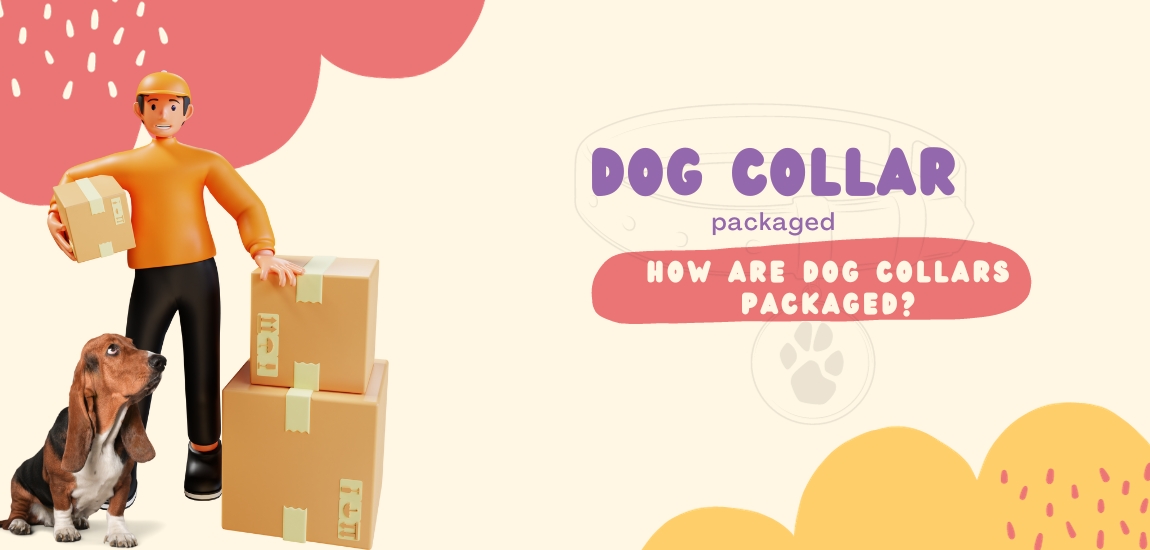Dog collars are a necessity for any pet owner, but have you ever wondered how they’re packaged for shipment and sale? This guide will walk you through the end-to-end how are dog collars packaged from the manufacturing facility to the pet store shelf.
Manufacturing and Material Selection
Most dog collars are manufactured overseas in large factories where different materials like nylon, leather, or chain link are die-cut or molded into collar shapes. Factors like the material, intended use, and price point help determine the packaging strategy.
Nylon and fabric collars are usually the most cost-effective to produce since they can be stamped out in high volumes. Leather and chain links require more labor to craft individually. Materials also impact shelf life – nylon may last years while leather can degrade more quickly over time.
Packaging Formats
There are a few main packaging formats used for dog collars:
Individual Bags or Sleeves
Single collars are often placed in small polybags or sleeves made of materials like plastic or Tyvek. This allows each collar to be felt or examined individually on store shelves.
Blister Cards
Some collars come mounted to coated cardboard “blister cards” that are sealed with a plastic cover. This displays the collar flat for easy visibility of colors, sizes, and features.
Multi-packs
Value packs containing 2-6 collars of the same style and size are bundled together in larger bags or boxes. This offers a discount for bulk purchases.
Boxes
Collars may also ship and sell in folding corrugate boxes containing assorted styles, sizes, and quantities. Bulk retailers prefer this bulk packaging format.
Specialty Packaging
Luxury collars may utilize durable fabric pouches, tin boxes, or other distinctive packaging befitting their higher price points.
Product Information and Legal Compliance
Regardless of format, all dog collar packaging must include certain critical product information:
- Branding – The manufacturer or retail brand name and logo promote brand recognition.
- Sizing – Collars intended for specific dog neck sizes are clearly marked in inches or centimeters.
- Materials – The materials used like nylon, leather, or chain are stated. This impacts allergies, abrasion resistance, and stainability.
- Closure Type – Buckles, clips, or other fasteners are identified so owners know how the collar is secured.
- Directions – Simple instructions clarify the proper fitting and use of the collar on a dog.
- Legal Compliance – All packaging conforms to child safety standards and lists company information and country of origin.
Packaging Design and POP Displays
Functional packaging is elevated with vibrant graphics, photos, and copy that amplify key benefits on the shelf:
- Bright colors attract attention and match popular dog breeds or activities.
- Lifestyle imagery depicts happy dogs and owners to build an emotional connection.
- Feature callouts highlight special properties like comfort edges, rustproof hardware, or lifetime guarantees.
Creative POP (point of purchase) displays built around packaging help drive impulse purchases in stores. Endcap shelving units, swing tags, and shelf talkers increase visibility and conversion.
Innovative Packaging Trends
Packaging trends evolve, and dog collar packaging is no exception. We’ll explore the latest innovations in packaging design, including unique shapes, vibrant colors, and interactive elements that make the unboxing experience memorable for both pets and their owners.
Benefits of Secure Packaging
Security is paramount when it comes to packaging dog collars. We’ll outline the benefits of secure packaging, touching on aspects like product protection, tamper resistance, and how it enhances the overall customer experience.
The Impact of Packaging on Consumer Perception
Packaging goes beyond practicality; it shapes the way consumers perceive a product. We’ll delve into the psychology behind packaging and how it influences purchasing decisions, making your dog’s collar not just a necessity but a statement piece.
DIY Dog Collar Packaging Ideas
For the creative pet owners out there, we’ve got some DIY packaging ideas to add a personal touch to your furry friend’s accessories. Get ready to unleash your creativity and make the packaging as unique as the collar itself.
Shipping and Distribution
Once beautifully packaged, collars ship palletized to warehouses or retailers around the world. Key considerations:
- Density – How collars are bundled maximizes the number shipped per container or truckload for efficiency.
- Layering – Fibre or foam sheets separate layers to prevent scratches or kinks in nylon or leather.
- Security – Strapping or wrapping secures loads during transportation.
- Environment – Temperature and humidity controls maintain quality during warehousing and transit times.
Distribution center workers then break down master cartons into smaller shipments tailored to individual retailers’ needs and restocking schedules.
Key Takeaways About Dog Collars Packaged
In summary, effective dog collar packaging balances protective properties, sales-enabling features, low costs, and sustainability. The right format supported by compelling graphics helps drive discovery and decision-making and gets the product safely into pet owners’ hands. With an understanding of the entire supply chain, retailers and consumers can appreciate the journey each collar makes from factory to pet parent.
FAQ About Dog Collars Packaged
What material is best for hot climates?
Nylon and breathable fabrics allow a dog’s neck to stay cool in warm weather compared to thick leather.
How do I choose between plastic or cardboard?
Plastic packaging lasts longer but uses more non-recyclable materials. Cardboard packaging is more eco-friendly overall.
Can packaging say if a collar is escape-proof?
No, the closure system would have to fail extensively through testing to legally claim a collar is “escape-proof.” Look for heavy-duty hardware instead.
Do I need a different collar for small dogs versus large breeds?
In general, yes. Make sure collars are an appropriate percentage of your pet’s neck size to avoid slippage or discomfort. 1/2 inch collateral for toy dogs versus 1-2 inches for large dogs.
How do I dispose of used packaging properly?
Recycle where possible! Plastic bags, blister cards, and corrugate can usually be placed loose or bundled in recycling bins. Non-recyclables should go in normal trash.


